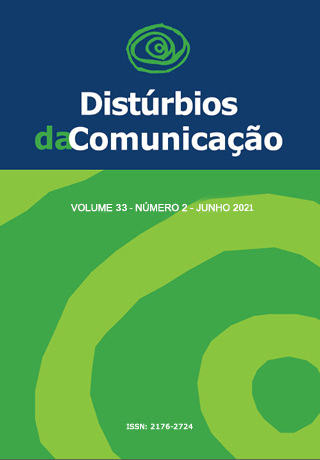Speech therapy performance in patients with esophagus cancer receiving radiotherapy treatment: A case series
DOI:
https://doi.org/10.23925/2176-2724.2021v33i2p249-256Keywords:
Speech, Language and Hearing Sciences, Esophageal Neoplasms, Radiotherapy, Deglutition Disorders, Quality of LifeAbstract
Introduction: Speech therapy performance in dysphagia resulting from esophageal cancer is still a recent subject. To date, there are no studies describing the speech therapy performance of patients with esophageal cancer undergoing radiotherapy. For this reason, the aim of this study was to describe speech therapy performance in patients with esophageal cancer receiving radiotherapy treatment and with complaints of dysphagia. Methods: This is a series of five cases, with patients that received outpatient speech therapy. The patients were assessed using clinical swallowing evaluation, classification of the degree of swallowing alteration with application of visual analog scale and quality of life protocols used in oncology. They also underwent a therapeutic approach to swallowing. Results: The patients’ swallowing was improved and, at the end of the treatment, there were reduced symptoms of dysphagia, possibility of oral intake of food and improved quality of life. Conclusions: Speech therapy, comprising the clinical assessment of the swallowing function, followed by swallowing training and myofunctional exercise to open the upper esophageal sphincter, supported the rehabilitation of esophageal dysphagia.
Downloads
References
INCA: Instituto Nacional do Câncer [internet]. Rio de Janeiro: Instituto Nacional do Câncer; c1995-2018. Estimativa 2018: Incidência de Câncer no Brasil. [Acesso em 2019 ago. 05]. Disponível em: http://www1.inca.gov.br/estimativa/2018/estimativa-2018.pdf.
Ruivo EAB, Mello JRC, Cavenaghi OM, Ferreira LL. Perfil sociodemográfico e clínico de pacientes com neoplasia de esôfago e estômago em um hospital escola de São José do Rio Preto, SP, Brazil. Rev Fac Ciênc Méd Sorocaba. 2017; 19(4): 189-95.
Kaneoka A, Yang S, Inokuchi H, Ueha R, Yamashita H, Nito T, et al. Presentation of oropharyngeal dysphagia and rehabilitative intervention following esophagectomy: a systematic review. Diseases of the Esophagus. 2018; 31(8): 1-11.
Steele CM, Alsanei WA, Ayanikalath S, Barbon CEA, Chen J, Cichero JAY, et al. The Influence of Food Texture and Liquid Consistency Modification on Swallowing Physiology and Function: A Systematic Review. Dysphagia. 2015; 30(1): 2–26.
Crary MA, Carnaby-Mann GD, Groher ME. Initial psychometric assessment of a Functional Oral Intake Scale for Dysphagia in stroke patients. Arch Phys Med Rehabil. 2005; 86(8): 1516-20.
Franceschini J, Jardim JR, Fernandes ALG, Jamnik S, Santoro IL. Reproducibility of the Brazilian Portuguese version of the European Organization for Research and Treatment of Cancer Core Quality of Life Questionnaire used in conjunction with its lung cancer-specific module. J Bras Pneumol. 2010; 36(5): 595-602.
Relvas-Silva M, Silva RA, Dinis-Ribeiro M. Portuguese Version of the EORTC QLQ-OES18 and QLQ-OG25 for Health-Related Quality of Life Assessment. Acta Med Port. 2017; 30(1): 47-52.
Fayers PM, Aaronson NK, Bjordal K, Groenvold M, Curran D, Bottomley A. EORTC QLQ-C30 Scoring Manual. European Organisation for Research and Treatment of Cancer. 2001; 3(86): 1-78.
Shaker R, Kern M, Bardan E, Taylor A, Stewart ET, Hoffmann RG, et al. Augmentation of deglutitive upper esophageal sphincter opening in the elderly by exercise. Am J Physiol. 1997; 272(6): G1518-22.
Henry MACA, Lerco MM, Ribeiro PW, Rodrigues MAM. Epidemiological features of esophageal cancer. Squamous cell carcinoma versus adenocarcinoma. Acta Cirurgica Brasileira. 2014; 29(6): 389-93.
Oliveira-Borges EC, Silva AF, Graças AM, Melo FFS, Barcelos AA, Myiata S. O câncer de esôfago: uma revisão. Revista da Universidade Vale do Rio Verde. 2015; 13(1): 773-90.
Ferreira TS, Mangilli LD, Sassi FC, Fortunato-Tavares T, Limongi SCO, Andrade CRFD. Speech and myofunctional exercise physiology: a critical review of the literature. J Soc Bras Fonoaudiol. 2011; 23(3): 288-96.
Halperin EC, Wazer DE, Perez CA, Brady LW. Perez and Brady’s Principles and practice of radiation oncology. 6rd ed. Philadelphia: Lippincott Williams & Wilkins; 2013.
Meerten EV, Gaast AVD, Looman CWN, Tilanus HWG, Muller K, Essink-Bot ML. Quality of life during neoadjuvant treatment and after surgery for resectable esophageal carcinoma. Int. J. Radiation Oncology Biol. Phys. 2008; 71(1): 160-6.
Scarpa M, Saadeh LM, Fasolo A, Alfieri R, Cagol M, Cavallin F, et al. Health-related quality of life in patients with oesophageal cancer: Analysis at different steps of the treatment pathway. J Gastrointest Surg. 2013; 17(3): 421–33.
Silva AIV, Galante C, Manzi FR. Efeito da radiação ionizante sobre o paladar em pacientes submetidos à radioterapia para a região da cabeça e pescoço. Radiologia Brasileira. 2011; 44(5): 297-300.
Downloads
Published
Issue
Section
License
Copyright (c) 2021 Bárbara Luísa Simonetti, Vera Beatris Martins, Monalise Costa Batista Berbert

This work is licensed under a Creative Commons Attribution 4.0 International License.









